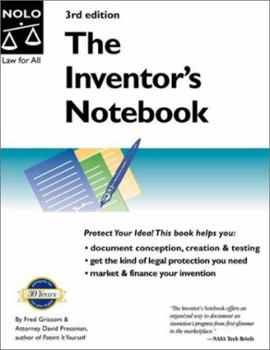The Inventor's Notebook
Select Format
Select Condition 
Book Overview
Face it: It's not enough to simply have a good idea for an invention, build it yourself, and expect to retire to Millionaire Acres. It doesn't work that way anymore, if it ever did. Here's a... This description may be from another edition of this product.
Format:Paperback
Language:English
ISBN:0873375998
ISBN13:9780873375993
Release Date:January 2000
Publisher:NOLO
Length:224 Pages
Weight:1.30 lbs.
Dimensions:0.6" x 8.4" x 10.8"
Customer Reviews
1 rating
A Superb Book
Published by Thriftbooks.com User , 18 years ago
One of the biggest mistakes inventors make is the failure to maintain adequate records for their inventions. This is often due to not understanding the vital importance of proper records from the standpoint of the U.S. patent laws. The law mandates that only the first and true inventor shall receive a patent. The Inventor's Notebook is primarily designed to provide the inventor with the records you will need to legally prove you are the "first and true inventor". Please note that it does not offer legal advice. Only your patent attorney or a patent agent can advise you as to the current state of the law with regard to your specific invention. Also, to better understand and appreciate its purpose, you should also read and study a good up-to-date guide to patent law, such as David Pressman's Patent It Yourself. In addition to providing the means to prove you are legally the first to invent, the Inventor's Notebook provides you with guidelines for making decisions regarding patentability, commerciality, and whether other paths could be taken -- e.g., keeping your invention a trade secret. The book is divided into four main parts -- a work diary, legal protection, marketing and financing. The work diary section gives you examples of how to record your invention with regard to its conception, purpose, description, operation, novelty, prior art and what the advantages of your invention are. It stresses the importance of drawing a line through blank sections to prevent others from later claiming material was added after the page was prepared, dated and witnessed. Entries must be made in ink and pencil sketches should be photocopied. The proper method for adding photos is also given. The legal section explains the importance of and how to make a prior art search. The term, "prior art", in patent law means any material that can be found that was on record before the date you conceived your invention and that might be used to deny your right to a patent. This includes prior patents, magazine articles, technical journals, books, catalogs, etc. The legal section includes pages for the recording of contacts made while developing your invention with emphasis on securing confidentiality agreements to protect your invention. It also stresses the extreme importance of the "one year rule", which requires that you must file your patent application within one year of the date on which you first publish, publicly use, sell or offer your invention, or any product that embodies same, for sale. The marketing section notes that you should avoid the trap many first-time inventors fall into -- namely, spending vast amounts of time, energy and money on your invention before checking out its commercial potential. It also warns of the very common trap of paying money to an "invention developer" who, quite often, cannot even furnish the names of any successful clients. The book provides a list of 34 positive factors and 21 negative factors for evaluating your invention





